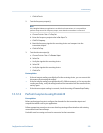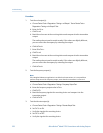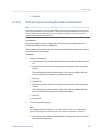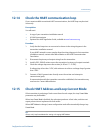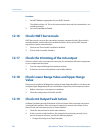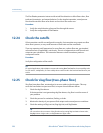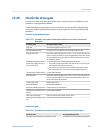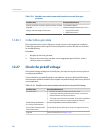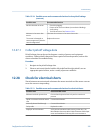
b. Read the frequency signal at the receiving device and compare it to the
transmitter output.
c. Choose End.
3. Test the discrete output(s).
a. Press Service Tools > Simulate > Simulate Outputs > Discrete Output Test.
b. Choose Off.
c. Verify the signal at the receiving device.
d. Press OK.
e. Choose On.
f. Verify the signal at the receiving device.
g. Press OK.
h. Choose End.
Postrequisites
• If the mA output reading was slightly off at the receiving device, you can correct this
discrepancy by trimming the output.
• If the mA output reading was significantly off (±200 microamps), or if at any step the
reading was faulty, verify the wiring between the transmitter and the remote device,
and try again.
• If the discrete output reading is reversed, check the setting of Discrete Output Polarity.
12.13 Check for radio frequency interference (RFI)
The transmitter's frequency output or discrete output can be affected by radio frequency
interference (RFI). Possible sources of RFI include a source of radio emissions, or a large
transformer, pump, or motor that can generate a strong electromagnetic field. Several
methods to reduce RFI are available. Use one or more of the following suggestions, as
appropriate to your installation.
Procedure
• Eliminate the RFI source.
• Move the transmitter.
• Use shielded cable for the frequency output or discrete output.
- Terminate the shielding at the output device. If this is impossible, terminate the
shielding at the cable gland or conduit fitting.
- Do not terminate the shielding inside the wiring compartment.
- 360-degree termination of shielding is unnecessary.
Troubleshooting
234 Micro Motion
®
Model 2700 Transmitters with Analog Outputs








